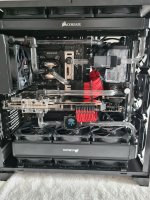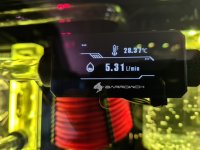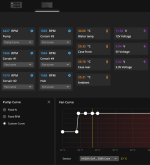Associate
I upgraded from AIO to a hardline build back in August 2021 flow rate was 150 L/H then slowly got worse and worse, thanks Aquasuite flow rate graphing!!
Now it won't go over 94 l/h at 100% pump speed, support article says min of 100 L/H is safe.
I recently had my D5 pump replaced as it appeared to be dying from the evidence I had to hand. Replaced it and also added an active backplate into the mix whilst I had it drained but flow rate still the same.
I had previously drained the whole loop, taken it apart, flushed the rads, dismantled the blocks and cleaned them and still the same result.
Also spent a long time rocking/turning/upending to ensure I got all the air out and bled air from the distro plate.
This link indicates that having a number of fittings in your build shouldn't impact flow massively either https://www.ekwb.com/blog/do-angled-adapter-fittings-really-reduce-flow/
Coolant under load hits around 36c.
So I guess what am I asking is..
1) People with similar hardware as below, what is your flow rate at 100% pump speed?
2) Is it possible to pressure blast the radiators incase there is a blockage my basic flush didn't pick up?
3) Sweet baby cheeses make a suggestion I haven't thought of.
Thanks for reading!
Lian Li Dynamic XL
13 x Angled fittings
4 x offset fittings
2 x tube bends
EK-Quantum Reflection PC-O11D XL D5 PWM D-RGB - Plexi
EK Water Blocks EK-Quantum Convection D5 Pump Cover - Nickel
EK Water Blocks EK-Quantum Vector MSI Trio RTX 3080/3090 D-RGB Water Block - Nickel + Plexi
EK-Quantum Vector TRIO RTX 3080/3090 Active Backplate D-RGB - Plexi
EK-Momentum MSI Z390 MEG Godlike D-RGB - Plexi
EK-CoolStream PE 360 (Top)
EK-CoolStream SE 360 (Side)
EK-CoolStream XE 360 (Bottom)
EK Fittings and 16mm Acrylic Tubing
Aquacomputer flow sensor high flow NEXT
Mayhems XTR Nano Tech Premixed Coolant
Now it won't go over 94 l/h at 100% pump speed, support article says min of 100 L/H is safe.
I recently had my D5 pump replaced as it appeared to be dying from the evidence I had to hand. Replaced it and also added an active backplate into the mix whilst I had it drained but flow rate still the same.
I had previously drained the whole loop, taken it apart, flushed the rads, dismantled the blocks and cleaned them and still the same result.
Also spent a long time rocking/turning/upending to ensure I got all the air out and bled air from the distro plate.
This link indicates that having a number of fittings in your build shouldn't impact flow massively either https://www.ekwb.com/blog/do-angled-adapter-fittings-really-reduce-flow/
Coolant under load hits around 36c.
So I guess what am I asking is..
1) People with similar hardware as below, what is your flow rate at 100% pump speed?
2) Is it possible to pressure blast the radiators incase there is a blockage my basic flush didn't pick up?
3) Sweet baby cheeses make a suggestion I haven't thought of.
Thanks for reading!
Lian Li Dynamic XL
13 x Angled fittings
4 x offset fittings
2 x tube bends
EK-Quantum Reflection PC-O11D XL D5 PWM D-RGB - Plexi
EK Water Blocks EK-Quantum Convection D5 Pump Cover - Nickel
EK Water Blocks EK-Quantum Vector MSI Trio RTX 3080/3090 D-RGB Water Block - Nickel + Plexi
EK-Quantum Vector TRIO RTX 3080/3090 Active Backplate D-RGB - Plexi
EK-Momentum MSI Z390 MEG Godlike D-RGB - Plexi
EK-CoolStream PE 360 (Top)
EK-CoolStream SE 360 (Side)
EK-CoolStream XE 360 (Bottom)
EK Fittings and 16mm Acrylic Tubing
Aquacomputer flow sensor high flow NEXT
Mayhems XTR Nano Tech Premixed Coolant






